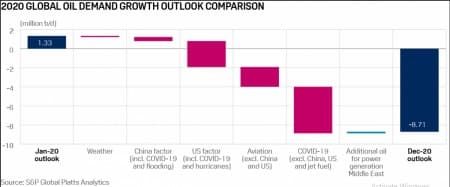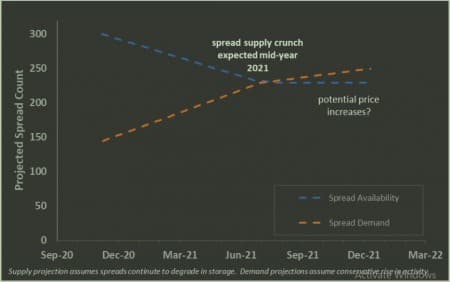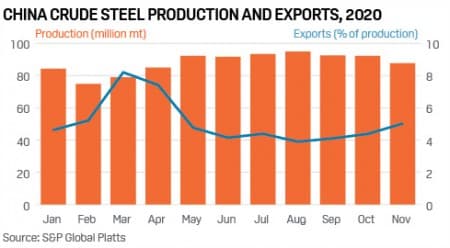Oil prices are rallying aggressively on the back of Saudi Arabia’s surprise cut and optimism over the rollout of vaccines across the world. News of a new strain of COVID19, however, has hurt the prospect of a demand recovery in Europe. The big question now for analysts is what does 2021 hold for oil markets?
The International Energy Agency (IEA) says that oil demand recovery will be slower in 2021 than previously thought. Reducing its projections by 170,000 barrels per day (bpd), the Paris based agency estimates that oil demand will be 5.7 mbpd in 2021. With reports of new lockdowns across Europe, demand in the transport sector will likely take a hit. Further, with recent flight bans from the UK, jet fuel demand will continue to be under pressure. In fact, according to the IEA, 80 percent of the decline in fuel consumption in 2021 from 2019 levels will be attributed to weak consumption of jet fuel. Analysis by S&P Global Platts suggests that demand will be 2.4 mbpd lower than 2019 levels, coming in at around 5.3 mbpd.

Primary Vision Network (PVN) has also released their End of Year Report for 2021, covering Natural Gas Liquids’ supply, consumption and demand in China, supply profiles by Pumpers, and much more. The PVN report says that they are “cautiously optimistic” regarding demand recovery and E&P activity in 2021. Producers can be expected to continue looking for cost savings where possible. The report points to tense relations between the U.S. and China as adding pressure to global economic activity. The report also highlighted the possibility of a Frac Spread supply crunch. Analysts also highlight how floating storage is rising in the North Sea and Europe while oil in transit is up. Commercial storage is getting crowded as well.

OPEC+ will also remain a key focus in 2021. Libyan production has risen and, according to a recent show by PVN, it could reach up to 1.2 mbpd. Data by S&P Platts suggests that OPEC pumped its most in November 2020, but Russia and Saudi Arabia will have their caps increased in 2021 and could choose to ramp up production. Meanwhile, members that are exempt are already increasing production, with Libya, Venezuela, and Iran adding more than 600,000 to the markets last month. We may expect the trend to continue next year.

China and its economic health will continue to make headlines next year. China almost single-handedly rescued commodity markets during the pandemic, but its imports are now slowing. The interplay between the U.S. and China will be a vital factor in how the Chinese economy performs in 2021.

Shale production is another significant factor to observe in 2021, with the new Biden administration likely to be less friendly to the oil and gas industry. In a recent Forbes article, Fernando Hernandez of Hernandez Analytica delved into exactly how a potential oil drilling ban in 2021 could impact the industry. Saudi Arabia’s recent decision to extend production cuts at the start of the year was very good news for U.S. drillers, but the industry is still in for a tough year if the global pandemic isn’t dealt with and if oil demand doesn’t rebound rapidly.
By Osama Rizvi for Oilprice.com
More Top Reads From Oilprice.com:
- The Next 5 Days Could See A Buying Spree In Oil Futures
- How To Play 2021’s First Oil Rally
- Rising LNG Prices Welcome News For U.S. Exporters



















Based on the sound fundamentals of the global oil market, OPEC+ production cuts, the rollout of vaccines across the world and China’s and India’s insatiable thirst for oil, global oil demand is projected to recover to 2019 levels by the middle of this year. Furthermore, Brent crude price is also projected to hit $60 a barrel in the first quarter of 2021 and rise to $70-$80 by the third quarter. It is projected to average $60-$65 in 2021.
As a rule, I ignore projections by the International Energy Agency (IEA) as politically-motivated and therefore inaccurate. The reason is that the IEA represents the world’s major consumers of oil (mostly western countries) and therefore its first priority is to secure low oil prices for its members through publishing data aimed at depressing oil prices.
A Biden administration will probably try to improve relations with China by removing tariffs on Chinese exports and ending the trade war in return for viable agreements on technology transfer, intellectual property and other issues.
Still, the trade war is not principally about trade surplus and alleged Chinese malpractices. It is about the petro-yuan undermining the supremacy of the petrodollar and by extension the US financial system, Taiwan, refusal by China to comply with US sanctions against Iran and Venezuela, China’s overwhelming dominance in the Asia-Pacific region and its sovereignty claim over 90% of the South China Sea, the new order in the 21st century and above all fear of the US losing its unipolar status.
I can neither see any prospects of growth for US shale oil production nor a comeback soon (or may be ever) to previous levels.The truth of the matter is that US shale oil hasn’t only lost a sizeable production as a result of the pandemic but also its importance to the global oil market. OPEC+ has finally won the war against the US shale oil industry.
The United States’ crude oil imports will eventually rise from 9 mbd in 2019 to an estimated 12-mbd-13 mbd in coming years.
Dr Mamdouh G Salameh
International Oil Economist
Visiting Professor of Energy Economics at ESCP Europe Business School, London
US oil and refined product demand peaked a decade ago and now most spectacularly so given what has happened with the North American Airline Industry.